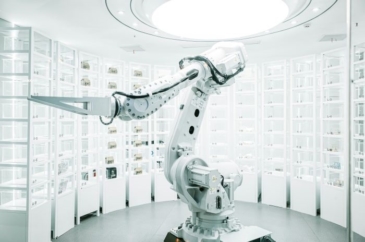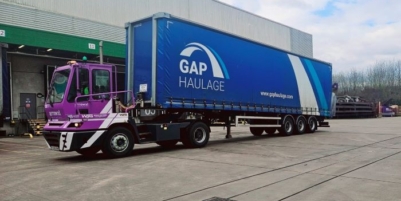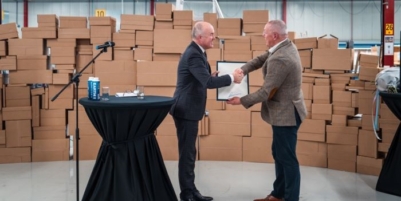-
Nutrivend selects Forterro’s Orderwise to support online expansion and streamline operations - April 11, 2025
-
ARROWXL LAUNCHES AMBITIOUS ZERO WASTE ROADMAP - April 8, 2025
-
THE BCMPA’S NEW CAMPAIGN DRIVES OUTSOURCING SUCCESS IN Q1 - April 7, 2025
-
BLACKOUT TECHNOLOGIES TARGETS TELEMATICS-INTEGRATED MOBILE DEVICE BLOCKING TO COMBAT SMARTPHONE DISTRACTION - April 1, 2025
-
Sparck Technologies awarded Royal designation - March 27, 2025
-
OpenADR Alliance announces first OpenADR 3.0 certified products with EVoke Systems, E.ON Energy and Universal Devices - March 25, 2025
-
Growing fulfilment and contract packer appoints new Managing Director - March 25, 2025
-
When is it time to invest in a WMS? Understanding the key trigger points - March 25, 2025
-
eCapital helps Vantage Recruitment on its journey to financial success - March 24, 2025
-
Hugo Beck Celebrates 70 Years of Packaging Innovation with Open House Events - March 20, 2025
While the current adoption rate of artificial intelligence (AI) technologies in warehousing is still relatively low, market projections indicate that there will be a significant growth in AI implementations over the next few years. Eric Carter, Solutions Architect at Indigo Software explores how AI will enhance intralogistics in the future.
For warehouse managers, adopting AI promises both operational efficiency and a substantial return on investment. By leveraging the vast amounts of data that warehouses naturally produce, AI can optimise processes, enhance productivity, and offer long-term savings. This article will explore how AI can be applied in warehouse environments and discusses some of the most common concerns about the impact of AI on the workforce.
Why does AI thrive in the data-rich warehouse environment?
The intralogistics environment and AI can be a perfect match. Warehouses are often inherently data-rich environments, generating massive amounts of valuable information related to product location, movement, inventory levels, and operational efficiency. AI systems, especially large language models (LLMs) and machine learning algorithms, thrive on high-quality, consistent data. The more data they can analyse, the better they become at identifying patterns, making predictions, and optimising performance.
Collecting data is always good
In an AI context, there is no such thing as ‘too much information’! The more data you gather, the better insight you will gain into your warehouse operations. Data-driven AI systems use the wealth of information generated by intralogistics to fine-tune processes, predict demand, and allocate resources more efficiently. For instance, the longer an AI system monitors your warehouse, the more accurate its predictions for stock replenishment or order fulfilment routes will become. Over time, these processes can be tweaked and fine-tuned – the result is a more efficient, cost-effective operation.
Key use cases of AI in warehousing
AI’s capabilities are very varied and extend across various operational areas, allowing warehouse managers to optimise and automate tasks, leading to significant productivity gains. Here are three of the most immediately viable use cases:
Route Optimisation:
Travelling around the warehouse can waste a lot of time and resource which is entirely preventable using AI. AI can dynamically adjust required routes for warehouse vehicles, such as forklifts or autonomous mobile robots (AMRs), to avoid congestion, reduce fuel consumption, and minimise wear and tear on machinery. By analysing real-time data, AI ensures that goods are moved as efficiently as possible, saving both time and resources.
Picking Optimisation:
Picking is another major cost centre in a warehouse and can represent up to 55% of the cost overhead. Using AI, warehouses can determine the most efficient picking routes for workers, reducing the time spent retrieving items. AI systems can prioritise urgent orders, ensuring they are picked and packed first, while reducing overall labour costs and speeding up the fulfilment process.
Improved Workforce Productivity:
AI-powered tools can assist warehouse workers by automating repetitive tasks, such as data entry and inventory tracking. By taking over these mundane tasks, AI enables staff to focus on more complex, value-adding activities. Additionally, AI-driven insights can help assign workers to the right tasks based on their skills, further improving productivity.
How to approach data capture for AI in intralogistics
The first step in AI adoption is ensuring you have robust data-gathering mechanisms in place, which is where a warehouse management system (WMS) comes into play. A WMS will generate and continuously capture vast amounts of operational data that AI systems can analyse. To ensure your data collection is as broad reaching and accurate as possible, it is important to ensure that different operational systems are fully integrated and can share data seamlessly in real-time. If the AI system has access to integrated data coming from a WMS, transport management system (TMS), and enterprise resource planning (ERP) system, it can support real-time decision-making across the supply chain.
Business value of AI investment
While some warehouse managers might be concerned about the initial costs of AI implementation, it is important to consider the long-term benefits and ROI. Many warehouses that have introduced AI have reported a return on investment within 12 months through increased efficiency, reduced errors, and lower workforce costs. Plus over time, as the adoption cycle moves into a more mature phase, AI solutions will become more affordable and accessible, especially for smaller companies.
Smaller warehouses can see especially large benefits from introducing AI because it can level the playing field by reducing dependency on manual planning and improving operational efficiency. For instance, AI-driven inventory optimisation helps reduce stockouts and overstock situations, improving customer satisfaction and reducing carrying costs.
Appreciating the workforce implications of AI
An early barrier to AI adoption was that could be perceived as a threat to warehouse jobs. Now that people’s understanding of the technology is improving, there is a greater appreciation that AI is not necessarily a job eliminator. In fact, a better way to understand its workforce impact is to consider it a ‘force multiplier’, because it enhances the productivity of the existing workforce by automating mundane tasks and allowing workers to focus on more complex activities.
At a time when most businesses are trying to reign in their expenditure, using AI to assist with decision-making and process optimisation will enable warehouses to achieve more target goals with the same number of staff, allowing businesses to scale without increasing their headcount.
In addition, as AI becomes more integrated with routine operations, warehouse managers and staff will need to develop new business skills. Just like the way PCs changed job roles decades ago and totally transformed office life, AI will create demand for workers skilled in data interpretation, system management, and collaboration across AI-powered tools.
Reskilling and developing a workforce for the future
The warehouse workforce of the future will need to adapt to AI-driven environments, and this will require companies to invest in upskilling their employees, ensuring that they are well equipped to work alongside AI systems. In particular, mid-career reskilling will be essential, as experienced workers will need to learn how to interact with AI tools and leverage the data collected for better decision-making.
Investing in training programs and certifications such as warehouse management qualifications that include AI training, will ensure employees are ready to maximise the potential of AI technologies. Additionally, companies should foster a culture of openness and adaptability, to encourage employees to embrace new technologies.
Is there a future for AI in warehousing?
Experts all agree that AI is set to become a very widely adopted technology in logistics, but successful implementations will depend on the openness and adaptability of an organisation. AI adoption in warehouses is expected to accelerate quickly, with data showing that the global AI market in supply chain and logistics is expected to grow significantly over the next decade.
However, AI adoption in the warehouse needs to be undertaken responsibly, with careful consideration of the risks to both the organisation and its workforce. By integrating AI thoughtfully and responsibly, warehouse managers can drive substantial improvements in productivity, safety, and worker satisfaction while securing a competitive edge in an increasingly AI-driven world.
































